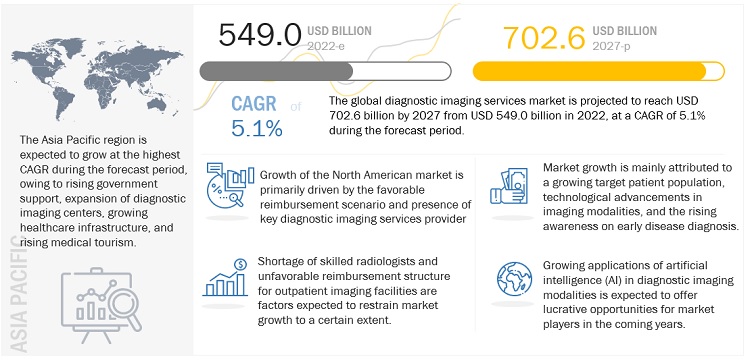The diagnostic imaging services market has witnessed substantial growth over the past decade, driven by advancements in imaging technology, increasing prevalence of chronic diseases, and a rising geriatric population. This market encompasses a wide range of procedures including Magnetic Resonance Imaging (MRI), Ultrasound, Computed Tomography (CT), X-Ray, Nuclear Imaging, and Mammography. Each of these procedures plays a critical role in the early detection, diagnosis, and management of various medical conditions. This article provides an in-depth analysis of the diagnostic imaging services market, focusing on these key procedures.
“Diagnostic Imaging Services Market Size, Growth by Procedure (MRI, Ultrasound, CT, X-RAY, Nuclear Imaging, Mammography) – Global Forecast to 2027” The diagnostic imaging services market size is projected to reach USD 702.6 billion by 2027, at a CAGR of 5.1%.
Download a PDF Brochure: https://www.marketsandmarkets.com/pdfdownloadNew.asp?id=17157849
MRI (Magnetic Resonance Imaging)
MRI is a non-invasive imaging technique that uses strong magnetic fields and radio waves to generate detailed images of organs and tissues within the body. The demand for MRI has been growing due to its ability to provide high-resolution images, which are crucial for diagnosing conditions such as brain disorders, spinal cord injuries, and musculoskeletal abnormalities. Advances in MRI technology, such as the development of 3T and 7T MRI machines, have significantly improved image clarity and reduced scan times, further boosting market growth.
The MRI segment is also benefiting from the increasing use of contrast agents that enhance image quality, making it easier to detect abnormalities. Additionally, the rise in chronic diseases like cancer and cardiovascular conditions has led to higher utilization of MRI for diagnostic purposes.
Ultrasound
Ultrasound imaging, also known as sonography, uses high-frequency sound waves to produce images of structures within the body. It is widely used due to its safety, non-invasiveness, and ability to provide real-time imaging. Ultrasound is commonly used in obstetrics and gynecology, cardiology, and emergency medicine.
The ultrasound market is experiencing growth due to advancements such as the development of portable and handheld devices, which make it easier to use in remote and point-of-care settings. Innovations in 3D and 4D ultrasound technology have also enhanced the diagnostic capabilities, providing more detailed and dynamic images. The increasing incidence of chronic diseases and the growing emphasis on early diagnosis and preventive healthcare are further driving the demand for ultrasound imaging.
CT (Computed Tomography)
CT imaging involves the use of X-rays and computer processing to create cross-sectional images of the body. It is a highly effective diagnostic tool for detecting a wide range of conditions, including cancers, cardiovascular diseases, and trauma injuries. The ability to provide detailed images of bone, soft tissues, and blood vessels makes CT scans indispensable in medical diagnostics.
The CT segment of the diagnostic imaging market is growing due to technological advancements such as the introduction of multi-slice CT scanners, which offer faster scan times and higher image resolution. The integration of artificial intelligence (AI) in CT imaging is also enhancing diagnostic accuracy and efficiency. Additionally, the increasing use of CT in oncology for tumor detection and treatment planning is contributing to market growth.
X-Ray
X-ray imaging is one of the oldest and most widely used diagnostic techniques. It involves the use of electromagnetic radiation to produce images of the inside of the body, primarily used to examine bones and detect fractures, infections, and tumors. Despite the emergence of more advanced imaging modalities, X-ray remains a fundamental tool in diagnostic imaging due to its cost-effectiveness and quick results.
The X-ray segment is evolving with the advent of digital radiography, which offers numerous advantages over traditional film-based X-ray, including faster image acquisition, enhanced image quality, and lower radiation exposure. Portable X-ray devices are also becoming increasingly popular, allowing for bedside imaging in hospitals and use in remote locations.
Nuclear Imaging
Nuclear imaging involves the use of small amounts of radioactive materials (radiotracers) to diagnose and determine the severity of diseases such as cancer, heart disease, and gastrointestinal, endocrine, and neurological disorders. Techniques like Positron Emission Tomography (PET) and Single Photon Emission Computed Tomography (SPECT) are key components of nuclear imaging.
The nuclear imaging market is growing due to advancements in radiotracer development and the increasing adoption of hybrid imaging systems such as PET/CT and SPECT/CT, which combine the functional imaging capabilities of PET or SPECT with the anatomical imaging provided by CT. These hybrid systems offer improved diagnostic accuracy and have become essential tools in oncology, cardiology, and neurology.
Mammography
Mammography is a specialized form of imaging that uses low-dose X-rays to examine breast tissue. It is the most effective screening tool for early detection of breast cancer. Regular mammography screening has been shown to significantly reduce breast cancer mortality by enabling early diagnosis and treatment.
The mammography market is witnessing growth due to technological advancements such as digital mammography, which provides better image quality and lower radiation doses compared to traditional film mammography. The introduction of 3D mammography (tomosynthesis) has further improved diagnostic accuracy by allowing radiologists to view breast tissue in thin, layered images, reducing the likelihood of false positives and negatives.
Conclusion
The diagnostic imaging services market is poised for continued growth, driven by technological advancements, increasing healthcare expenditure, and the rising prevalence of chronic diseases. Each imaging modality, including MRI, Ultrasound, CT, X-Ray, Nuclear Imaging, and Mammography, plays a vital role in the diagnosis and management of various medical conditions. As technology continues to evolve, the diagnostic capabilities and efficiency of these imaging techniques will further improve, enhancing patient care and outcomes.
Insightful Content: https://www.prnewswire.com/news-releases/diagnostic-imaging-services-market-worth-702-6-billion-by-2027–exclusive-report-by-marketsandmarkets-301634137.html

Leave a comment